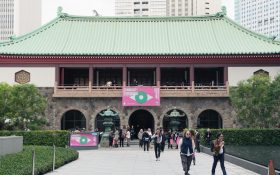She’ll be 40 next year, is tall, black, beautiful, elegantly proportioned, has finely chiselled features and her ribs show through. I once used up an entire year’s worth of carbon footprint allowance just to go and see her, in downtown Chicago. She is, I’m sure you know, the John Hancock Tower. Occasionally, like this, when architecture and engineering merge in perfect harmony the consequence is an iconic building or structure. Engineering can even do this on its own. And cities need such icons or signature buildings – they identify the place and draw the inquisitive in.
I want to consider time, money and value in relation to the achievement of icon status buildings and works.
Time and money are often said to be synonymous, but as long as you get there in the end that’s frequently enough these days to trump both commodities. In Britain we’ve become inured to the over-run of our major construction projects like Wembley Stadium, the Dome and not least, here in Scotland, the Scottish Parliament. Before that lot, remember the Channel Tunnel and Blue Streak? Or further back, Brunel’s Great Eastern steamship. It’s in the blood it seems, and not just ours. None of these had an easy birth and at least one didn’t even provide good value by making it to icon status. Why? Because the design simply wasn’t good enough.
Now, think of an on-going construction project with no rivals. A true cutting-edge development that’s involving international co-operation and some of the best engineering brains in the world. It’s late, of course, and it’s somewhat over budget too. In fact it’s costing more than the GDP of most countries in the world, and that’s after having been scaled back every year since building work started. Can you guess what it is yet? But for its rationality, you might think that Frank Gehry provided the inspiration for the exterior, clad as it is in curved metal sheeting, glinting in the sun, and sticking out at strange and perilous angles.
This is a construction project that might be completed in another three years, at which time the main contractor is going to pull out, finished or not. Then, unlike most bridges, tunnels, buildings, planes, it’s only expected to last about seven years, despite regular maintenance, before failing. The total cost of this enterprise is currently estimated at not less than $100 billion dollars, but you know how estimates have a habit of changing. The design itself is changing all the time (it’s getting smaller) as the cost continues to grow. And what’s it all for? Well, a bit of dubious science seems to be the best answer. The complex is being kitted out with masses of computers, the odd scientific laboratory and lots and lots of reusable energy units all bolted together and flapping around on the outside – expressed functionalism à la Richard Rogers at Lloyds and the Pompidou Centre.
So, to recap: It’s not what it should have been. It’s very, very late so can’t function as originally intended. It might not get finished. It will fail after a short life. It’s too expensive to be viable for any short term use – and there is no long term. People have been occupying it since 2000 but for the most part they’ve been doing housekeeping tasks or, more correctly, waste products stowage. Otherwise, they’ve been courageously taking lots of photographs and, I dare say, in quieter moments have been wondering why they’ve been bravely sent.
Yes, this is the most expensive, most ridiculous building project ever undertaken by mankind, the International Space Station, Alpha. Constructionally, it is a dazzling achievement, although it didn’t make the recently published New Seven Wonders list. You’d be mean to call it anything other than an engineering marvel. There is something inherently satisfying about pure engineering structures and there is no more suitable location to find one than orbiting at 220 nautical miles above Earth. But can we go and see it? No, that’s an option only for the über-rich. One thing this is not, not even a pale shadow of, is Arthur C. Clarke and Stanley Kubrick’s space station in the film 2001. Pan-Am will not be flying shuttle missions for anyone. Alpha is supposed to be part of NASA’s strategy for returning to the moon and for their projected manned missions to Mars, but as neither of these is scheduled to happen before 2020, it doesn’t take a rocket scientist to see that Alpha’s orbit will have decayed, fatally, well before that! I’m backing the Chinese to get to the moon first, with Virgin Galactic a close second. So, can we use it in any way? Erm, no. So why are we building it? An engineering triumph it might be, but it’s also a white elephant and as political an animal as the Dome was ten years ago. “What we need is a grand gesture!” Build it first, then think what to do with it later.
I loved the spinning, artificial gravity station of 2001 and I could see that it looked both credible and desirable, not descriptions that sit well with Alpha (check www.shuttlepresskit.com/ISS_OVR/). It’s like being seduced by Garden Cities only to be allocated a cell in a remote tower block.
What I want to know is why we can’t have a proper rotating station, a Space City where we can all go to visit. Clarke did his research and it was good. And furthermore, Blue Danube is much more appropriate than Paul McCartney screaming “Good Day, Sunshine” at the awakening astronauts/tourists (Mission Control please note).
One day in about ten years time this crossover space architecture/installation piece will light up the night skies briefly, and the light-pollution-free skies of the Highlands would be a good place to witness its self-destruction on de-orbit. Gormley might call it Event Explosion. NASA will probably say that the largest building ever constructed in space represented the finest technology in its day but that new challenges require modern solutions. They will only be confirming that the signature building of Earth orbit has really been a jumped up Job Creation Project. Being out of sight, it’s also out of mind, so not very real. But just take a moment to think about the cost in relation to the benefit. It’s a difficult sum to balance, and the European Space Agency is a contributing partner. That’s you and me.
We paid for the Scottish Parliament too. How tragic if Alpha’s debris were to come down at the bottom of the Royal Mile in Edinburgh. Two albatrosses, one stone. And next time, maybe instead of crazy Catalan ideas that produce a maximum surface area envelope, we could draw on history and have a building adapted to its climate and which encloses space with the minimum possible envelope (where do you think space technology got some of its best ideas from?). The design has to be right and history shows us that government-led projects don’t often acknowledge the importance of this.
The Scottish Parliament buildings were very late, considerably over budget, not what they should have been and hardly fit for purpose. Worse, they possess the aesthetics of an airport terminal or a railway station and aren’t in any way iconic! Poor deal. I feel a dramatic installation event coming on.

_Encounters-in-Reflection_Gallery3BPhoto-by-Anpis-Wang-e1745414770771.jpg?w=280)


